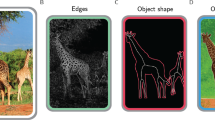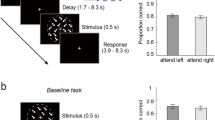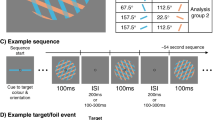Abstract
Object-based theories of attention propose that the selection of an object's feature leads to the rapid selection of all other constituent features, even those that are task irrelevant. We used magnetoencephalographic recordings to examine the timing and sequencing of neural activity patterns in feature-specific cortical areas as human subjects performed an object-based attention task. Subjects attended to one of two superimposed moving dot arrays that were perceived as transparent surfaces on the basis either of color or speed of motion. When surface motion was attended, the magnetoencephalographic waveforms showed enhanced activity in the motion-specific cortical area starting at ∼150 ms after motion onset, followed after ∼60 ms by enhanced activity in the color-specific area. When surface color was attended, this temporal sequence was reversed. This rapid sequential activation of the relevant and irrelevant feature modules provides a neural basis for the binding of an object's features into a unitary perceptual experience.
This is a preview of subscription content, access via your institution
Access options
Subscribe to this journal
Receive 12 print issues and online access
$209.00 per year
only $17.42 per issue
Buy this article
- Purchase on Springer Link
- Instant access to full article PDF
Prices may be subject to local taxes which are calculated during checkout






Similar content being viewed by others
References
Posner, M.I., Snyder, C.R.R. & Davidson, B.J. Attention and the detection of signals. J. Exp. Psychol. 109, 160–174 (1980).
Wolfe, J.M. Guided search 2.0 A revised model of visual search. Psychon. Bull. Rev. 1, 202–238 (1994).
Chen, Z. Object-based attention: a tutorial review. Atten. Percept. Psychophys. 74, 784–802 (2012).
Scholl, B.J. Objects and attention: the state of the art. Cognition 80, 1–46 (2001).
Boehler, C.N., Schoenfeld, M.A., Heinze, H.-J. & Hopf, J.-M. Object-based selection of irrelevant features is not confined to the attended object. J. Cogn. Neurosci. 23, 2231–2239 (2011).
Hopf, J.M., Heinze, H.J., Schoenfeld, M.A. & Hillyard, S.A. Spatio-temporal analysis of visual attention. in The Cognitive Neurosciences IV (ed. Gazzaniga, M.S.) 235–250 (MIT Press, Cambgridge, Massachusetts, 2009).
Desimone, R. & Duncan, J. Neural mechanisms of selective visual attention. Annu. Rev. Neurosci. 18, 193–222 (1995).
Duncan, J. Selective attention and the organization of visual information. J. Exp. Psychol. Gen. 113, 501–517 (1984).
Duncan, J., Humphreys, G.W. & Ward, R.M. Competitive brain activity in visual attention. Curr. Opin. Neurobiol. 7, 255–261 (1997).
Roelfsema, P.R. Cortical algorithms for perceptual grouping. Annu. Rev. Neurosci. 29, 203–227 (2006).
O'Craven, K.M., Downing, P.E. & Kanwisher, N. fMRI evidence for objects as the units of attentional selection. Nature 401, 584–587 (1999).
Schoenfeld, M.A. et al. Dynamics of feature binding during object-selective attention. Proc. Natl. Acad. Sci. USA 100, 11806–11811 (2003).
He, Z.J. & Nakayama, K. Visual attention to surfaces in three-dimensional space. Proc. Natl. Acad. Sci. USA 92, 11155–11159 (1995).
Valdes-Sosa, M., Cobo, A. & Pinilla, T. Transparent motion and object-based attention. Cognition 66, B13–B23 (1998).
Valdes-Sosa, M., Cobo, A. & Pinilla, T. Attention to object files defined by transparent motion. J. Exp. Psychol. Hum. Percept. Perform. 26, 488–505 (2000).
Schoenfeld, M.A. et al. Spatio-temporal analysis of feature-based attention. Cereb. Cortex 17, 2468–2477 (2007).
Rodríguez, V., Valdes-Sosa, M. & Freiwald, W. Dividing attention between form and motion during transparent surface perception. Brain Res. Cogn. Brain Res. 13, 187–193 (2002).
Duncan, J. in Attention and Performance XVI (ed. McClelland, J.L.) 549–578 (MIT Press, Cambridge, Massachusetts, 1996).
Singer, W. Neuronal synchrony: a versatile code for the definition of relations? Neuron 24, 49–65, 111–125 (1999).
Palanca, B.J. & DeAngelis, G.C. Does neuronal synchrony underlie visual feature grouping? Neuron 46, 333–346 (2005).
Hadjikhani, N., Liu, A.K., Dale, A.M., Cavanagh, P. & Tootell, R.B. Retinotopy and color sensitivity in human visual cortical area V8. Nat. Neurosci. 1, 235–241 (1998).
Zeki, S., McKeefry, D.J., Bartels, A. & Frackowiak, R.S. Has a new color area been discovered? Nat. Neurosci. 1, 335–336 (1998).
Seymour, K., Clifford, C.W., Logothetis, N.K. & Bartels, A. The coding of color, motion and their conjunction in the human visual cortex. Curr. Biol. 19, 177–183 (2009).
Stoppel, C.M. et al. Feature-based attention modulates direction-selective hemodynamic activity within human MT. Hum. Brain Mapp. 32, 2183–2192 (2011).
Katzner, S., Busse, L. & Treue, S. Attention to the color of a moving stimulus modulates motion-signal processing in macaque area MT: evidence for a unified attentional system. Front. Syst. Neurosci. 3, 12 (2009).
Wannig, A., Rodriguez, V. & Freiwald, W.A. Attention to surfaces modulates motion processing in extrastriate area MT. Neuron 54, 639–651 (2007).
Treisman, A. Feature binding, attention and object perception. Phil. Trans. R. Soc. Lond. B 353, 1295–1306 (1998).
Egly, R., Driver, J. & Rafal, R.D. Shifting visual attention between objects and locations: evidence from normal and parietal lesion subjects. J. Exp. Psychol. Gen. 123, 161–177 (1994).
Goldsmith, M. & Yeari, M. Central-cue discriminability modulates object-based attention by influencing spatial attention. Exp. Psychol. 59, 132–137 (2012).
Law, M.B. & Abrams, R.A. Object-based selection within and beyond the focus of spatial attention. Percept. Psychophys. 64, 1017–1027 (2002).
He, X., Fan, S., Zhou, K. & Chen, L. Cue validity and object-based attention. J. Cogn. Neurosci. 16, 1085–1097 (2004).
Kasai, T. Attention-spreading based on hierarchical spatial representations for connected objects. J. Cogn. Neurosci. 22, 12–22 (2010).
Martínez, A., Teder-Salejarvi, W. & Hillyard, S.A. Spatial attention facilitates selection of illusory objects: evidence from event-related brain potentials. Brain Res. 1139, 143–152 (2007).
Martínez, A. et al. Objects are highlighted by spatial attention. J. Cogn. Neurosci. 18, 298–310 (2006).
Muller, N.G. & Kleinschmidt, A. Dynamic interaction of object- and space-based attention in retinotopic visual areas. J. Neurosci. 23, 9812–9816 (2003).
Zinni, M.M.A. & Hillyard, S.A. The neural basis of color binding to an attended object. in Electrophysiology of Attention: Signals of the Mind (ed. Mangun, G.R.) (Elsevier, New York, 2013).
Sohn, W., Papathomas, T.V., Blaser, E. & Vidnyanszky, Z. Object-based cross-feature attentional modulation from color to motion. Vision Res. 44, 1437–1443 (2004).
Khoe, W., Mitchell, J.F., Reynolds, J.H. & Hillyard, S.A. Exogenous attentional selection of transparent superimposed surfaces modulates early event-related potentials. Vision Res. 45, 3004–3014 (2005).
Reynolds, J.H., Alborzian, S. & Stoner, G.R. Exogenously cued attention triggers competitive selection of surfaces. Vision Res. 43, 59–66 (2003).
Guthrie, D. & Buchwald, J.S. Significance testing of difference potentials. Psychophysiology 28, 240–244 (1991).
Acknowledgements
We would like to thank M. Wachter for help with the data collection and N. Nönnig and M. Scholz for technical support. This work was supported by grants Scho1217/1-2 and SFB779 TP A1 from the Deutsche Forschungsgemeinschaft (DFG) and by grants from the US National Science Foundation (BCS-1029084) and the National Institute of Mental Health (1P50MH86385).
Author information
Authors and Affiliations
Contributions
M.A.S. designed and performed the experiments, analyzed the data and wrote the paper. J.-M.H. designed the experiments and analyzed the data. C.M. analyzed the data. H.-J.H. supervised the performance of the experiments and data analysis. S.A.H. designed the experiments, supervised the performance of the experiments and data analysis, and wrote the paper.
Corresponding author
Ethics declarations
Competing interests
The authors declare no competing financial interests.
Integrated supplementary information
Supplementary Figure 1 Source activity waveforms from experiment 1
The two traces at the top show the averaged source activity waveforms for motion sensitive sources in the middle occipital gyri (red tracing) and color sensitive sources in inferior occipital cortex (blue tracing) from Experiment 1, where selection of the surface was based on motion speed and color was the task-irrelevant feature. The subsequent four source activity waveforms (red tracings) originate from left and right motion-sensitive sources in the middle occipital gyri obtained from the analysis of the differences formed by subtracting the ERF on grey-slow*/red-fast trials from the ERF on grey-slow/red-fast* trials (first two red waveforms) and grey-fast/red-slow* trials from ERFs on grey-fast*/ red-slow trials (last two red waveforms). The bottom four source activity waveforms (blue tracings) originate from left and right color-sensitive sources in the inferior occipital cortex obtained from the differences formed by subtracting the ERF on grey-slow*/red-fast trials from the ERF on grey-slow/red-fast* trials (first two blue waveforms) and grey-fast/red-slow* trials from ERFs on grey-fast*/ red-slow trials (last two blue waveforms). Note that all waveform deflections are positive (upwards) regardless of the sign of the subtractions, since these waveforms depict positive current density measures.
Supplementary Figure 2 Source activity waveforms from experiment 2
The two traces at the top show the averaged source activity waveforms for color sensitive sources in inferior occipital cortex (blue tracing) and motion sensitive sources in the middle occipital gyri (red tracing) from Experiment 2, where selection of the surface was based on color and motion was the task-irrelevant feature. The subsequent four source activity waveforms (blue tracings) originate from left and right color-sensitive sources in the inferior occipital cortex obtained from the differences formed by subtracting the grey-slow*/red-fast trials from ERFs on grey-slow/red-fast* trials (first two blue waveforms) and subtracting the grey-fast*/red-slow trials from ERFs on grey-fast/red-slow* (last two blue waveforms). The bottom four source activity waveforms (red tracings) originate from left and right motion-sensitive sources in the middle occipital gyri obtained from the differences formed by subtracting the grey-slow*/red-fast trials from ERFs on grey-slow/red-fast* trials (first two red waveforms) and subtracting the grey-fast*/red-slow trials from ERFs on grey-fast/red-slow* (last two red waveforms).
Supplementary information
Supplementary Text and Figures
Supplementary Figures 1 and 2 (PDF 1420 kb)
Rights and permissions
About this article
Cite this article
Schoenfeld, M., Hopf, JM., Merkel, C. et al. Object-based attention involves the sequential activation of feature-specific cortical modules. Nat Neurosci 17, 619–624 (2014). https://doi.org/10.1038/nn.3656
Received:
Accepted:
Published:
Issue Date:
DOI: https://doi.org/10.1038/nn.3656
This article is cited by
-
Object-based attention in complex, naturalistic auditory streams
Scientific Reports (2019)
-
Early recurrence and ongoing parietal driving during elementary visual processing
Scientific Reports (2015)



